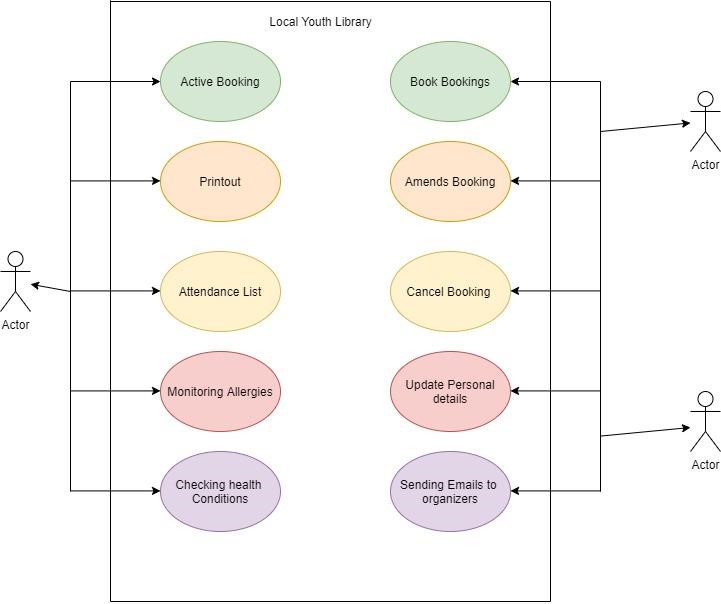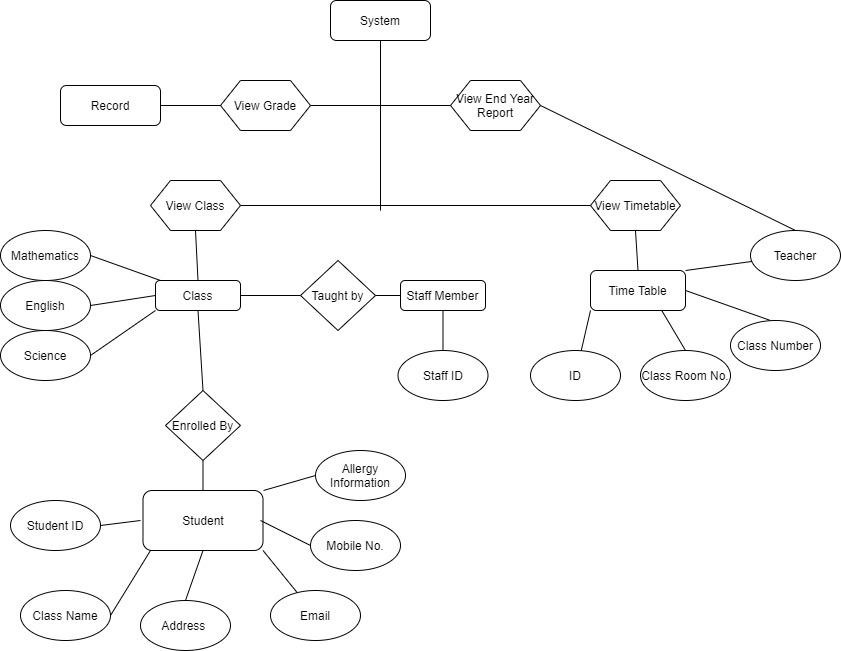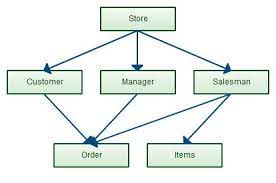CIS010-6 ASSIGNMENT SAMPLE – DATA MODELLING AND MANAGEMENT 2022
Q1.
a)
The importance of the use of case diagrams can be seen in the system which is influenced by both internal as well as external influences. Requirements of case diagram required a lot of costs and it can be said that the cost is more than the design requirements. Jain requirements incorporate with a different type of complex project and for this purpose, there can be seen the use of a case diagram who is helping the developers to understand the requirements of the systems very easily (Petrova et al. 2019).
- The importance of the case diagram can be found in its name where the specific case is chosen to identify the functionality of the performance.
- The sustainability of the name of the actor can be ensured.
- The case diagram can define the development of dependencies and the relationship.
- Deer can be seen in certain diagrams which are used in which type of relationships are the main aim of those diagrams is to modify the requirements.
- The requirements can be clarified by the use of notes in which the important point can be noted down.
b)
Helping the business with completing different objectives the case scenario has been used and this is done by providing them with certain districts which will be suitable for different types of works both in an internal and external factor. There can be seen the direct business process forever it can be seen a proper presentation of the case scenario has been conducted in an efficient manner.
There can be seen certain differences at the time of interacting with some specific entities in the organisation for the enhancement of the goal of the business. On the other hand, are there can be seen the use of different processes for reflecting the case. Both the straight and linear paths can be reflected which had a direct flow that is associated with the scenario.
c)

Figure 1: Use case diagram
(Source: Self-made in Draw.io)
Q2
a)
The “entity-relationship diagram” or “ERD” is basically known as the relationship model of any entity and it is referred to as a picture presentation. This diagram finds the relationship that can be seen between the place, object and people and along with the information generally in the use of technology, there can be seen the use of an entity-relationship diagram.
The entity-relationship diagram can be used for the process of data modelling which is is the most essential feature of any business and the relational database of any business can be managed by the entity-relationship diagram. Visual presentation can be seen by the use of an entity-relationship diagram in which the design can be seen from the starting point of the design database and this is associated with the requirements of the organisation (Tavast et al. 2018).
Different types of reference points can be rolled out by entity relationship diagram which is considered as the National database. Then the process of debugging can be done after the successful creation of the entity-relationship diagram. The entity-relationship diagram is considered very useful in organising different types of data which is presented by the relational structure.
This relational structure is referred to as the sufficient form to represent different types of semi-structured and unstructured data.
Entity
Entities are referred to as different types of objects which contain relatively important data from Windows data sets. Some of the common entities can be defined as owner, customer, renter, salesman etc. Entities are assigned a particular task in the system.
Attribute
These are defined as different type of character qualities that can be seen in different types of entities. Attributes are directly interlinked with entities. For representing the data in the column there can we see the importance of attributes?
Relationship
It defines the linking between attributes and entities in a particular scenario for a system. By analysing the linking between entities and attributes The entity-relationship model can be built.
b)
A secondary school in Luton has as of late utilized an expert who has recorded an understudy framework record. As far as recording certain data sets the school is utilizing a data set cloud framework with all the pertinent data. Understudies can without much of a stretch utilize this sort of framework which audits the matrix print just as the schedule for the year finishing report.
Every single understudy has a unique ID, in a class where they are tended to with the name, email number and legitimate data that is given from the home. These frameworks can likewise be utilized by the staff as far as recording the accessibility of the classes which are for the most part recorded into the class for every single subject like English, Maths and Science.
The instructors or staff are the individuals from that ID that is given to the understudy which is practical to the educators or the subject top of the Year (Mellor, 2018). It tends to be additionally allocated through a conveyance of classes with more than one class.
Every educator shows just one subject where each class is coordinated with a rundown of understudies with a few IDs. The framework is additionally utilized for making the timetable where each opening can be a period table with an extraordinary ID for study hall class number just as a marked meeting by an instructor.

Figure 2: UML Diagram
(Source: Self-created in Draw.io)
Q3
a)
Select * From Member;
- b)
CREATE TABLE MEMBER
(
MemberID int,
FirstName varchar(75),
Surname varchar(75),
ContactNumber varchar(75),
ContactEmail varchar(75),
Address varchar(75),
Current BOOLEAN NOT NULL
);
c)
The “SQL WHERE” close can be used for specifying conditions at the time of fetching data from a table which can be single or multiple. If the condition that is given is satisfied then there can be seen the return of a specific value from that table (Psychoula and Chen).
The where clause is generally used to filter different types of records and switching the necessary data from those records.
Example: select * from member where memberid = 1;
- d)
Select Distinct Memberid From Member Order By Membername;
Q4
a)
For organising the data of a full database there can be seen the utilisation of the process named data normalisation. The data normalisation process is associated with a different type of otablesle and relationship established between differentypespe of the factor for designing and protecting both the data and the database.
It is considered as the very essential sector to normalise the database with the help of list duplicate data for ensuring that all the the columns and rows of the table are filled with the data. By this process different type of issues in the database can be mitigated like modification for updates of any data and delete a session as well as insertion of data.
By utilising the normalisation process the Data integrity of the database can be e increased and data redundancy can be decreased.

It works on the presentation of the inquiry “WHERE” standardize the data set likewise partitioned into various information bases that comprise of tables just as connection between those tables. For instance, the standardization of information.
These four sorts of information are known as 1NF, 2NF, 3NF 4NF and 5NF. Connection of 1nf comprises of a nuclear worth full stop; the connection of 2nf is a non key quality for the entire useful advancement which depends on the essential key. The relationship of 3nf and 2nf depends on the progress of reliance followed by the connection of 4nf is the BIOS code WHERE no multivalued reliance.
The utilization of standardization is profoundly significant for any utilitarian association. Associations need to set up a data set which should be minimal and comprises of significant data. The employments of the standardization can likewise confine the odds of information repetition.
It is seen that the standardization assisted the data set with giving the specific data. Open the data set contains data which isn’t dependable and with the current setting. The congestion of the data can cause this genuine intricacy of the information base and can likewise bring about complete disappointment of it.
b)
| “Subject” | Format | “Publication type” | Publisher | “Publisher country” | Title | “General Name” | Author | “Author nationality” | Pages | “Thickness” | Price |
| Literature | Fiction | Self-publication | Roli Books | India | 1 | Novels and arts | M. Peter | Christian | 1021 | 12 | $87 |
| Computer | Textbook | Literary journals | Westland publications | India | 2 | Data logics | J. Anthony | Christian | 950 | 20 | $82 |
| Maths | Textbook | Scholarly journals | Hachette India | India | 3 | Reasoning | C. Peter | Christian | 850 | 25 | $95 |
Table 1: First Normalisation
(Source: MS-Word)
2NF
| Subject | Format | Publisher | Title | Author | Author nationality | Price |
| Literature | Fiction | Roli Books | 1 | M. Peter | Christian | $87 |
| Computer | Textbook | Westland publications | 2 | J. Anthony | Christian | $82 |
| Maths | Textbook | Hachette India | 3 | C. Peter | Christian | $95 |
Table 2: Second Normalisation
(Source: MS-Word)
3NF
| Title | General name |
| 1 | Novels and arts |
| 2 | Data logics |
| 3 | Reasoning |
Table 3: Title format
(Source: MS-Word)
Reference List
Journals
Beeton, N.J. and Johnson, C.N., 2019. Modelling horse management in the Australian Alps. Ecological Management & Restoration, 20(1), pp.57-62.
Huynh, T.L.D., Shahbaz, M., Nasir, M.A. and Ullah, S., 2020. Financial modelling, risk management of energy instruments and the role of cryptocurrencies. Annals of Operations Research, pp.1-29.
Kamilaris, C., Dewhurst, R.J., Sykes, A.J. and Alexander, P., 2020. Modelling alternative management scenarios of economic and environmental sustainability of beef finishing systems. Journal of Cleaner Production, 253, p.119888.
Lv, T., Yan, P. and He, W., 2018, August. Survey on JSON data modelling. In Journal of Physics: Conference Series (Vol. 1069, No. 1, p. 012101). IOP Publishing.
Mellor, R.B., 2018. Big data modelling the knowledge economy. International Journal of knowledge-based development, 9(3), pp.206-220.
Petrova, E., Pauwels, P., Svidt, K. and Jensen, R.L., 2019. In search of sustainable design patterns: Combining data mining and semantic data modelling on disparate building data. In Advances in informatics and computing in civil and construction engineering (pp. 19-26). Springer, Cham.
Psychoula, I., Chen, L. and Chen, F., 2017, October. Privacy modelling and management for assisted living within smart homes. In 2017 IEEE 19th International Conference on e-Health Networking, Applications and Services (Healthcom) (pp. 1-6). IEEE.
Tavast, A., Langemets, M., Kallas, J. and Koppel, K., 2018, July. Unified data modelling for presenting lexical data: The case of ekilex. In Ed. J. Čibej, V. Gorjanc, I. Kosem & Simon Krek, Proceedings of the XVIII EURALEX International Congress: EURALEX: Lexicography in Global Contexts, Ljubljana (pp. 749-761).
Know more about UniqueSubmission’s other writing services:


Can you be more specific about the content of your article? After reading it, I still have some doubts. Hope you can help me.